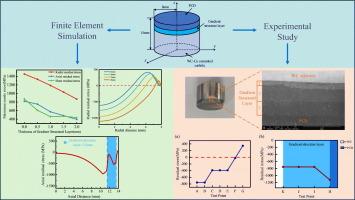粉末分层法制备功能梯度PDC残余应力的系统研究:仿真与实验验证
IF 5.1
3区 材料科学
Q2 MATERIALS SCIENCE, COATINGS & FILMS
引用次数: 0
摘要
聚晶金刚石压片(PDC)是在高温高压条件下将高纯度金刚石粉末烧结到WC-Co硬质合金基体上合成的一种高性能复合材料。它在石油钻探和地质勘探等应用中表现出卓越的性能。然而,在合成后的冷却阶段,PDC内部会产生显著的残余应力,这被认为是PDC失效的主要原因。本文采用数值模拟与实验相结合的方法,从优化残余应力的角度对梯度结构PDC进行了研究。通过数值模拟分析了梯度结构多晶金刚石压块中的残余应力以及梯度层厚度对残余应力的影响,确定了制备样品的最佳总厚度。结果表明,与常规PDC相比,梯度结构PDC可显著降低残余应力大小,改善残余应力分布,且梯度层越厚,改善效果越显著。采用粉末铺层法制备梯度结构PDC样品。扫描电镜结果表明,梯度层呈渐变过渡形态,层间烧结良好。EDS结果证实了设计的梯度结构的成功制造,显示出实际和预期元素分布之间的良好一致性。利用激光拉曼光谱对梯度结构PDC的残余应力进行了测量,结果与仿真结果吻合较好。梯度层侧面、PCD/梯度层界面、WC/梯度层界面均处于压应力作用下,残余应力变化明显。本文章由计算机程序翻译,如有差异,请以英文原文为准。

A systematic study on residual stress of functionally graded PDC fabricated by powder-layering: Simulation and experimental verification
Polycrystalline diamond compact (PDC), a high-performance composite material, is synthesized by sintering high-purity diamond powder onto a WC-Co cemented carbide substrate under HTHP conditions. It exhibits exceptional performance in applications such as petroleum drilling and geological exploration. However, significant residual stresses develop within PDC during the cooling stage following synthesis, which are recognized as a primary source of PDC failure. This paper investigates gradient-structured PDC from the perspective of optimizing residual stress, combining numerical simulation with experiments. Numerical simulations were conducted to analyze the residual stress in gradient-structured polycrystalline diamond compact and the influence of gradient layer thickness on residual stress, establishing the optimal total thickness for sample fabrication. Results demonstrate that gradient-structured PDC significantly reduces residual stress magnitude and improves its distribution compared to conventional PDC, and the thicker the gradient layer, the more significant the improvement. Gradient-structured PDC samples were fabricated via the powder layer-spreading method. Through scanning electron microscopy, it was shown that the gradient layers exhibited a gradual transition morphology with good sintering between layers. EDS results confirmed the successful fabrication of the designed gradient structure, showing good agreement between the actual and intended elemental distributions. The residual stress of gradient-structured PDC was measured using laser Raman spectroscopy, and the results were consistent with the simulation. The side of the gradient layer, PCD/gradient-layer interface and WC/gradient-layer interface are all under compressive stress, indicating significant residual stress modification.
求助全文
通过发布文献求助,成功后即可免费获取论文全文。
去求助
来源期刊

Diamond and Related Materials
工程技术-材料科学:综合
CiteScore
6.00
自引率
14.60%
发文量
702
审稿时长
2.1 months
期刊介绍:
DRM is a leading international journal that publishes new fundamental and applied research on all forms of diamond, the integration of diamond with other advanced materials and development of technologies exploiting diamond. The synthesis, characterization and processing of single crystal diamond, polycrystalline films, nanodiamond powders and heterostructures with other advanced materials are encouraged topics for technical and review articles. In addition to diamond, the journal publishes manuscripts on the synthesis, characterization and application of other related materials including diamond-like carbons, carbon nanotubes, graphene, and boron and carbon nitrides. Articles are sought on the chemical functionalization of diamond and related materials as well as their use in electrochemistry, energy storage and conversion, chemical and biological sensing, imaging, thermal management, photonic and quantum applications, electron emission and electronic devices.
The International Conference on Diamond and Carbon Materials has evolved into the largest and most well attended forum in the field of diamond, providing a forum to showcase the latest results in the science and technology of diamond and other carbon materials such as carbon nanotubes, graphene, and diamond-like carbon. Run annually in association with Diamond and Related Materials the conference provides junior and established researchers the opportunity to exchange the latest results ranging from fundamental physical and chemical concepts to applied research focusing on the next generation carbon-based devices.
 求助内容:
求助内容: 应助结果提醒方式:
应助结果提醒方式:


